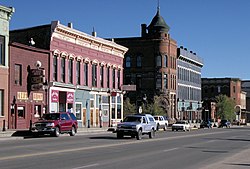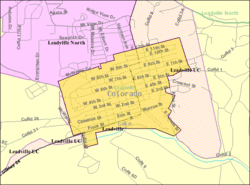Leadville
| City of Leadville, Colorado | |
|---|---|
| Statutory City | |

Downtown Leadville
|
|
| Nickname(s): The Two-Mile-High City, Cloud City | |
 Location in Lake County and the State of Colorado |
|
 U.S. Census Map |
|
| Coordinates: 39°15′00″N 106°17′30″W / 39.25000°N 106.29167°WCoordinates: 39°15′00″N 106°17′30″W / 39.25000°N 106.29167°W | |
| Country | United States |
| State | Colorado |
| County | Lake County Seat |
| Founded | 1877 |
| Incorporated | February 18, 1878 |
| Government | |
| • Type | Statutory City |
| Area | |
| • Total | 1.1 sq mi (2.86 km2) |
| • Land | 1.1 sq mi (2.86 km2) |
| • Water | 0.0 sq mi (0.0 km2) |
| Elevation | 10,152 ft (3,094 m) |
| Population (2010 census) | |
| • Total | 2,602 |
| • Density | 2,358.3/sq mi (910.5/km2) |
| Time zone | Mountain (MST) (UTC-7) |
| • Summer (DST) | MDT (UTC-6) |
| ZIP codes | 80429 (PO Box), 80461 |
| Area code(s) | 719 |
| FIPS code | 08-44320 |
| GNIS feature ID | 0204683 |
|
|
|
Leadville is the statutory city that is the county seat and only incorporated municipality in Lake County, Colorado, United States. The city population was 2,602 at the 2010 United States Census. Situated at an elevation of 10,152 feet (3,094 m), Leadville is the highest incorporated city and the second highest incorporated municipality in the United States. A former silver mining town that lies near the headwaters of the Arkansas River in the heart of the Rocky Mountains, the Leadville Historic District contains many historic structures and sites from its dynamic mining era. In the late 19th century, Leadville was the second most populous city in Colorado, after Denver.
The Leadville area was first settled in 1859 when placer gold was discovered in California Gulch during the Pikes Peak Gold Rush. By 1860, a town, Oro City ("oro" is the Spanish word for gold) had sprung up and a year later its population had reached more than 5,000. But the boom was brief because the placer-mined gold soon ran out and Oro City never became a major settlement.
The early miners had noted that mining for placer gold was hampered by heavy black sand in the sluice boxes, and in 1874 it was discovered that the heavy sand that impeded gold recovery was the lead mineral cerussite, which has a high silver content. Prospectors traced the cerussite to its source, present day Leadville, and by 1876 had discovered several silver-lead lode deposits.
...
Wikipedia
